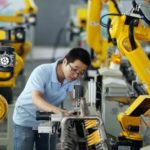 The number of industrial robots in operation around the world has grown rapidly in recent years, but nowhere more so than in China, where some 30% of the world’s robots are in operation. A recent study explores what the roots of this growth have been, and what the implications of the growth in robotics in China might be for the future of work.
The number of industrial robots in operation around the world has grown rapidly in recent years, but nowhere more so than in China, where some 30% of the world’s robots are in operation. A recent study explores what the roots of this growth have been, and what the implications of the growth in robotics in China might be for the future of work.
The researchers collected data from the China Employer-Employee Survey to gauge how many firms are using robots. The data shows that, as in other countries, robots first made an appearance in sectors such as electronics and automotive, with this growth underpinning tremendous growth in both sectors. Indeed, China now produces more cars than Japan and the United States combined, while over 70% of the world’s computers and electronics are made in China.
The authors speculate that the rise of industrial robotics in China is largely a consequence of the declining working-age population in the country, coupled with rising wages. These have coincided with a clear desire from the government to try and lead the 4th industrial revolution.
For instance, in 2013 the Chinese Ministry of Industry and Information Technology (MIIT) issued guidance on the development of the robotics industry, with this then supplemented by the Made in China 2025 program, which was launched in 2015. This set the goal of producing 100,000 industrial robots per year by 2020. The MIIT also announced a clear strategy to promote the use of robots in other sectors, especially in the service sector of the economy.
Investing in robots
At a firm level, this government backing and the rising cost and availability of labor have factored heavily in the investment decisions of firms. With such strong backing for the use of robotics throughout the country, the authors speculate that the government clearly see no reason to be concerned by the rising popularity of robotics, especially in terms of job replacement.
They suggest that this largely positive perspective on robotics is in part due to the positive image science and technology has in the country, and the importance of it in driving the country forward internationally.
From an employees perspective, the authors suggest that a lack of union infrastructure in the country and high voluntary turnover rates undermine any resistance to the introduction of robots into the workplace.
Unwarranted fears
Of course, a study from a few years ago suggests that such fears of widespread job displacement may be somewhat overblown. The study saw over 300 occupations examined over a 33 year time-scale from 1980 to try and examine the impact of automation. To put it bluntly, it emerged that employment generally rose fastest in professions with the most automation.
“The idea that automation kills jobs isn’t true historically, and if you look at the last 30 years, it’s not true then either,” the author says. “Right now, the best thing that can happen to you is to get some automation to do your job better.”
The analysis emerged from an exploration of occupations and salary from the U.S. Census Bureau and the Bureau of Labor Statistics.
For instance, the dissemination of ATM machines is widely used to typify the loss of jobs to automation, yet the report reveals that the number of bank tellers has actually increased each year since 2000.
It emerged that because ATMs reduced the costs involved in running a branch, banks were able to open more of them, therefore increasing the number of tellers needed.
Rather than jobs being eliminated, it suggests that instead new roles will be created and those roles will take on new responsibilities to better compliment what the automation has taken off their plate.